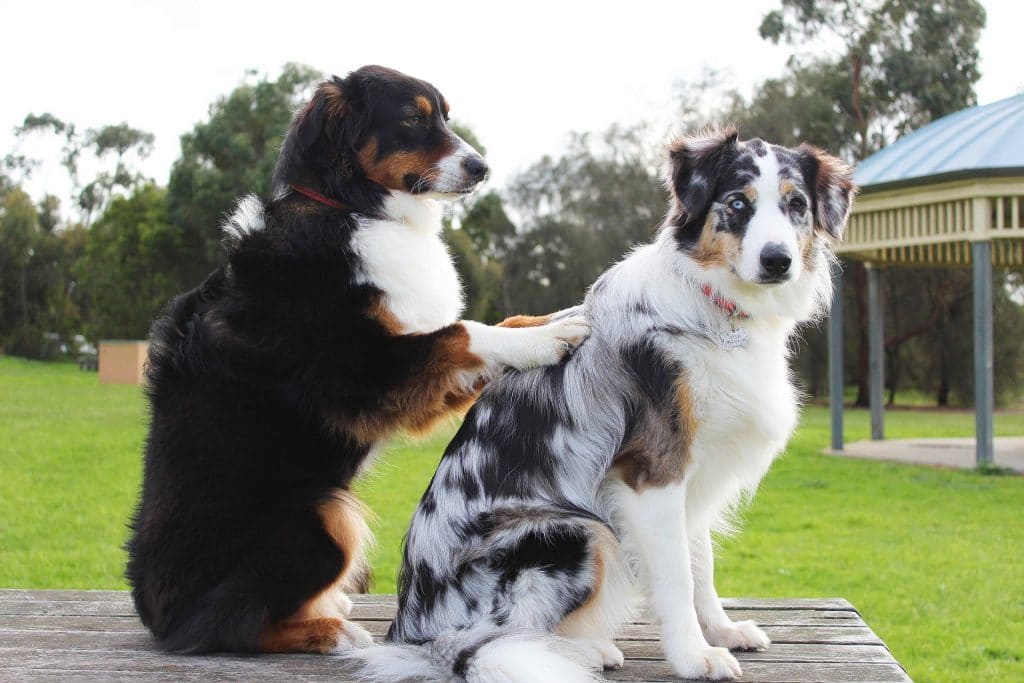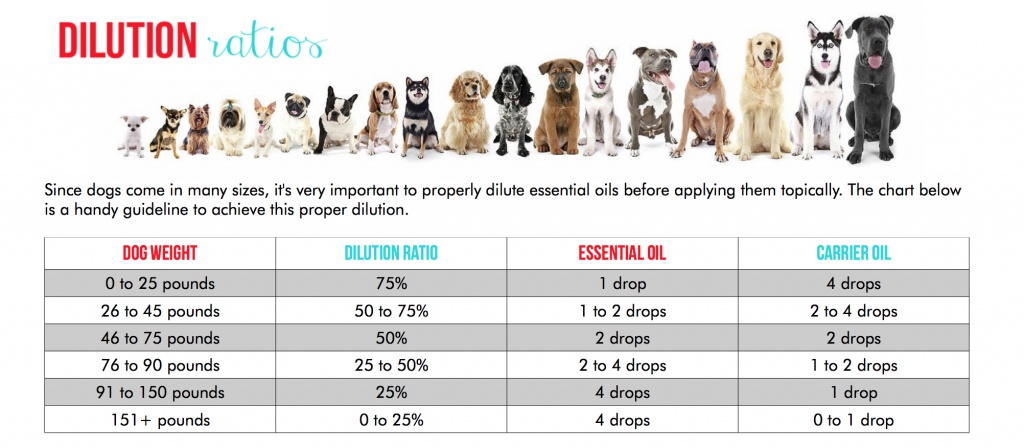- Cet article contient des liens d’affiliation. En savoir plus ici.
- Not a substitute for professional veterinary help.
Vous avez peut-être entendu parler des vertus médicinales des huiles essentielles. Pourraient-elles avoir un effet semblable sur votre chien? Est-ce que les huiles essentielles sont sécuritaires pour votre chien? Quelles huiles peuvent être mauvaises pour les chiens?
Avec un récent intérêt grandissant pour les huiles essentiels suscité par des entreprises comme doTerra, bien des parents d’animaux veulent en savoir plus sur cette approche et ne sont pas certains s’il s’agit d’une bonne idée.
Comme technicienne en santé animale, on m’a souvent demandé si les huiles essentielles sont mauvaises pour les chiens. J’ai voulu en savoir plus sur la question et voici ce que j’ai trouvé.
Huiles essentielles sécuritaires pour les chiens
Voici une courte liste des huiles essentielles qui sont sécuritaires pour les chiens, tel que le recommandent les experts :
- Lavande :Huile universelle. Utile pour le conditionnement des patients à un nouvel endroit. Peut aider lors d’allergies, de brûlures, d’ulcères, d’insomnie, d’anxiété et du mal des transport, pour ne nommer qu’eux. Ne pas utiliser chez le chat.
- Copaiba : Soutient les systèmes cardiovasculaire, immunitaire, digestif, urinaire, respiratoire, musculosquelettique et neveux.
- Encens : Favorise la santé et l’immunité cellulaire. Soutient le système nerveux et l’appareil digestif.
- Menthe poivrée : Soutient le système respiratoire et apaise les douleurs articulaires
- Petitgrain : Aide à calmer les systèmes nerveux et digestif. Bon pour les chiens qui vivent des stress et de l’anxiété.
Huiles essentielles mauvaises pour les chiens
Certaines huiles peuvent être toxiques pour les chiens lorsqu’elles sont ingérées ou qui entrent en contact avec la peau. Voici des huiles essentielles mauvaises pour les chiens.
- Arbre de thé : Les symptômes de toxicité comprennent la dépression, la perte de coordination, la paralysie de l’arrière-train, les vomissements, une baisse de température corporelle et une irritation de la peau.
- Cannelle : Les symptômes de toxicité comprennent une faible glycémie, des maladies du foie, des vomissements, de la diarrhée et des fluctuations dans le rythme cardiaque.
- Agrumes : Les symptômes de toxicité comprennent une irritation de la peau, de l’agitation ou de la léthargie, des vomissements, des tremblements, des convulsions.
- Menthe pouliot : Les symptômes de toxicité comprennent des vomissements et de la diarrhée – souvent sanguinolentes – en raison d’une insuffisance hépatique. Vous pouvez observer une léthargie. Consultez un vétérinaire sans tarder, car la toxicité de la menthe pouliot peut provoquer la mort chez le chien.
- Pin : Les symptômes de toxicité comprennent une irritation de la peau ou de l’estomac, des vomissements (probablement avec présence de sang). De la salivation, des faiblesses, une perte de coordination, des dommages au système nerveux central et de possibles effets sur les reins et le foie.
- Bouleau doux : Les symptômes de toxicité comprennent de graves ulcères gastro-intestinaux, une insuffisance rénale, des convulsions et la mort.
- Thé des bois : Les symptômes de toxicité comprennent des vomissements causés par de graves dérangements et ulcères dans l’estomac. La toxicité du thé des bois peut aussi causer à de l’insuffisance rénale et hépatique.
- Ylang ylang : Les symptômes de toxicité comprennent de la difficulté à respirer, des faiblesses, une démarche chancelante et des vomissements.
Comment en déterminer la qualité?
Les huiles essentielles sont extraites des plantes et la qualité de l’huile varie selon divers facteurs comme l’ensoleillement, l’altitude et même la quantité d’eau que la plante reçoit. L’Aromathérapie est l’utilisation des huiles essentielles (les concentrés, les huiles extraites des plantes par la distillation, en généralement par évaporation).
Les huiles essentielles produites pour l’aromathérapie sont généralement traitées avec beaucoup de soin. Pourquoi? Et bien, elles coûtent cher! Par exemple, 220 kg de lavande permet de produire seulement à peine plus de 3 kg d’huile essentielle de lavande. L’autrice de Holistic Aromatherapy for Animals, Kristen Leigh Bell, écrit que « les huiles qui sont produites spécialement pour l’industrie de l’aromathérapie sont produites avec le même soin et la même attention qu’on le ferait pour un grand vin. »
La pureté ne rime toutefois pas toujours avec sécurité, tout comme « naturel » ne signifie pas toujours « usage sécuritaire ». Les huiles essentielles sont très puissantes, car elles sont très concentrées. C’est pourquoi il est préférable de les diffuser par évaporation et de ne jamais les donner à l’animal pour qu’il l’ingère.
La plupart des experts vétérinaires vous avertiront aussi de ne pas les appliquer topiquement. Lorsqu’elle est utilisée sur la peau, une huile doit être diluée dans une huile support. Toujours consulter un vétérinaire avant d’en faire l’essai.
Même si vous utilisez une huile essentielle sécuritaire pour les chiens, il faut faire attention au nombre d’applications et à la concentration des huiles. Certaines huiles sécuritaires peuvent devenir toxiques si elles sont en trop grande quantité et d’autres peuvent être accidentellement absorbées par la peau ou causer des brulures de contact si elles sont mal appliquées.
De quelle façon les huiles essentielles et l’aromathérapie aident-elles les chiens?
Des huiles essentielles sécuritaires pour les chiens sont prévues pour tout traiter chez le chien de l’irritation cutanée au traitement antipuce. La lavande est populaire pour les chiens en raison de son effet calmant, par exemple.
Mon chien Max, souffre d’anxiété et la lavande a été efficace pour aider à le calmer. Nous ajoutons quelques gouttes de lavande dans le diffuseur pour huiles essentielles qui est dans la cuisine avant de quitter la maison.
La communauté vétérinaire holistique appuie leur utilisation. Un récent sondage mené auprès de ce groupe de vétérinaires démontre un usage varié des huiles essentielles : diffuser de la lavande dans la salle d’attente, utiliser des huiles essentielles pour le contrôle des odeurs, donner un petit massage avec de l’encens et bien plus.
La Dre Janet Roark, vétérinaire, ou « Dre huiles essentielles », propose de nombreux excellents liens et plusieurs ressources sur les bienfaits des huiles essentielles chez les animaux sur son site Internet.
Toutefois, il n’y a que très peu de recherche faite sur le sujet et, par conséquent, il y a un manque de faits pouvant confirmer si les huiles essentielles procurent bien tous les bienfaits qu’on leur confère.
Si elles ne sont pas bien utilisées, certaines huiles essentielles présentent des risques pour les chiens. Les chats sont encore plus sensibles à ces huiles et les oiseaux ne devraient pas en être proches. Cela dit, même si les huiles essentielles sont sécuritaires pour les chiens, vous pourriez mettre les autres animaux de la maison en danger.
Si vous voulez en savoir plus au sujet des huiles essentielles pour votre animal, assurez-vous de faire appel à un professionnel.
Comment utiliser des huiles essentielles pour votre animal?
Les études ont mené à la conclusion suivante au sujet des huiles essentielles pour vos animaux : MOINS ON EN DONNE, MEILLEUR LE RÉSULTAT.
Toujours commencer par une huile essentielle de qualité thérapeutique et vérifier que vous n’utilisez pas une huile qui est mauvaise pour les chiens.
- Comme ligne directrice générale, ajouter 3 à 6 gouttes d’huiles essentielles à 30 ml (1 oz) d’huile support.
- Utiliser une plus petite quantité d’huile diluée sur les petits chiens, comparativement aux grands chiens et encore moins sur les chiots et les chiens âgés.
- Utiliser un hydrosol, un sous-produit aqueux obtenu par distillation à la vapeur des huiles essentielles.
Dr Roark ajoute les précautions qui suivent lors d’un usage des huiles essentielles chez le chien :
- Ne pas appliquer sur le contour des yeux, dans les oreilles, sur le nez ou la région génitale.
- Faire preuve de vigilance pour les femelles gestantes ou qui allaitent.
- Connaissez bien l’état de santé et le comportement de votre animal et cessez l’utilisation d’Es que vous avez une préoccupation.
Prenez note que tous ces conseils sont destinés à un usage chez le chien seulement. En général, les huiles essentielles sont plus dangereuses chez le chat et vous devez absolument consulter votre vétérinaire avant de planifier leur utilisation chez le chat.
Quelques conseils de sécurité de plus
Les chiens sont plus sensibles aux huiles essentielles que les humains, donc même si vous vous y connaissez pour votre propre usage, il peut en être tout autre pour votre chien.
- N’utilisez que des huiles essentielles qui visent un état précis, présent et actif chez votre chien; ne faites pas de traitement préventif.
- N’ajoutez pas d’huiles essentielles à la nourriture et à l’eau de votre chien.
- Évitez les huiles essentielles pour les chiots de moins de 10 semaines et pour les chiennes gestantes ou qui allaitent.
- N’utilisez pas d’huiles sur les chiens souffrant d’épilepsie ou qui sont prédisposées à avoir des convulsions.
Symptômes d’empoisonnement aux huiles essentielles chez le chien
Si les huiles essentielles sont à la portée des animaux, même si elles sont sécuritaires pour les chiens, elles présentent un risque d’ingestion accidentelle.
Gardez l’œil ouvert pour détecter ces symptômes :
- Tremblement musculaire
- Faiblesse
- Difficulté à marcher
- Baisse de la température corporelle
- Salivation excessive
- Vomissements
- Frottement excessif de la gueule et du visage avec les pattes
Si vous croyez que votre chien a ingéré une huile essentielle, contactez votre vétérinaire ou le centre antipoison (1 800 463-5060) sans tarder. Il est toujours mieux d’agir rapidement.
Pour plus de conseils sur la sécurité et l’utilisation des huiles essentielles chez le chien, nous vous recommandons l’excellent livre (anglais) Holistic Aromatherapy for Animals par Kristen Leigh Bell.
Enfin, n’oubliez pas de consulter votre vétérinaire avant d’essayer toute huile essentielle sur votre chien.
Pour en savoir plus


